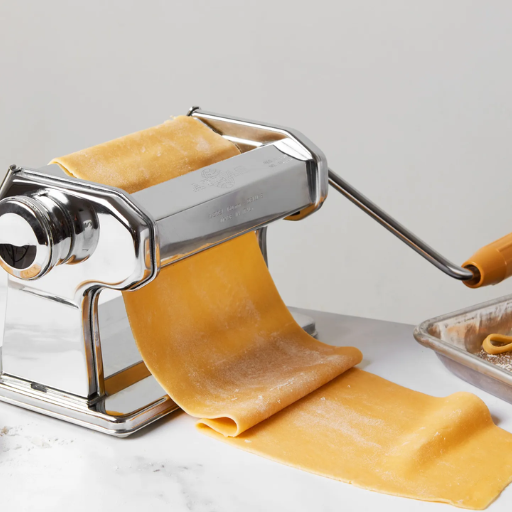The struggle for handcrafted pasta remains a unique element in today’s culinary scene. Nevertheless, store-bought pasta is convenient; nonetheless, the consistency and taste of homemade pasta cannot be compared to any other. That is why many people who are serious about their cooking at home do not just cook their meals with it but have this kind of machine. This ultimate guide will take you through some of the best manual pasta makers as of 2024, enabling you to find what suits your cooking needs best. Coming from different designs that have shown time does not affect them to highly developed ones that incorporate new technology; our choices are wide-ranging among other options. Whether you have mastery or zero knowledge in the kitchen, we provide comprehensive reviews and buying tips that will assist you in making an informed choice so that you can make restaurant-quality pasta right from your house.
What is a Manual Pasta Maker and How Does It Work?
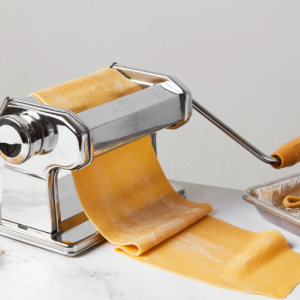
Image source: https://www.epicurious.com/
A manual pasta maker is a kitchen utensil. It is used to press, shape, and cut dough into various types of pasta. Typically, these things are operated by a hand crank. They are made up of two main parts: rollers and cutters. The rollers help flatten the dough to any thickness you want, while the cutters enable one to create different shapes, such as spaghetti or lasagna sheets and fettuccine. Pass the dough over the rollers and through the cutters repeatedly until it reaches an even texture and form as required. These machines are known for their simplicity, long-lasting nature, and superiority in controlling how pasta is cooked.
Understanding the Basics of a Manual Pasta Maker Machine
A manual pasta maker makes pasta simple by allowing users to determine how thick or thin they want their pasta to be. Among its main parts are cutting attachments and a pair of adjustable rollers. This requires putting the dough through these rollers and progressively changing their positions to obtain the desired thickness. Finally, it is run through cutters, which results in various pasta shapes. Manual pasta makers are unlike electric models because they use a hand crank for better control and precision. Moreover, such machines tend to be cheaper and more long-lasting, thus serving as valuable additions to any kitchen. They are designed so that even people with no experience can get started on homemade pasta quickly.
How to Use a Manual Pasta Roller Effectively
- Make the Dough Ready: First, prepare the pasta dough to be well-kneaded and allowed to rest. This will help ensure that there are no lumps, which is crucial for it to roll out easily and shape itself.
- Prepare the Machine: Make sure your manual pasta roller is tightly clamped to a stable surface. Start with the maximum position of the rollers.
- Flatten the Dough: Divide your dough into manageable portions. Flour lightly, then position on rollers while turning the crank handle. Double up your dough, then reposition it through rollers twice successively, each time reducing its thickness setting by little increments.
- Desired Thickness Achieved: Continue changing roller settings and passing the dough through until the desired thickness is achieved. Usually, pasta dough needs about five to six times through roller.
- Cutting the Dough: When the dough has thinned enough, attach a selected cutting attachment. Gently pass the dough sheet down through a cutter, such as spaghetti fettuccine or other pasta shapes.
- Air-drying or Cooking Pasta: Put cut pasta pieces on a drying rack or other clean, flat surface so that they dry slightly before cooking. Alternatively, you can drop freshly made pasta into salted boiling water immediately.
For successful pasta rolling, consistency in thickness and accuracy in flour application are essential, as sticking should be avoided at all costs. With more frequent practice, you will learn this skill, thus improving your personal experience when making homemade noodles.
Difference Between Manual and Electric Pasta Makers
Manual and electric pasta makers operate the same way but differ notably in their function and ease of use.
Manual Pasta Makers:
- Operation: The user has to rotate a hand crank for the dough to roll out.
- Control: Their control is more critical when making them have different thicknesses as you can adjust them gradually.
- Cost: Usually less expensive and do not need electricity, thus being economical.
- Portability: Lighter in weight since they are small and lack electrical parts, which makes them easier to store.
- Durability: Generally viewed as more vital because there are fewer moving parts.
Electric Pasta Makers:
- Operation: They operate automatically and do not require much or any human effort. The cutting and rolling are done by the machine itself.
- Efficiency: Suitable for producing large quantities of pasta very fast because it prepares food faster.
- Ease of Use: It is easy to operate and requires little physical effort when preparing food, perfect for those who want convenience.
- Versatility: Multiple models come with various settings or attachments for different types of pasta, such as noodles and spaghetti, among others, that may be required at times
- Size and Cost: These are normally bigger in size than manual alternatives, thus permanently occupying some space on a kitchen counter. They also use electricity, forcing you to plug in order to work.
Both kinds of equipment have advantages; however, the final decision depends on what you prefer most: control over your product /time spent or money used. You should also consider your property where you will keep all this stuff.
How to Choose the Best Manual Pasta Maker for Your Kitchen
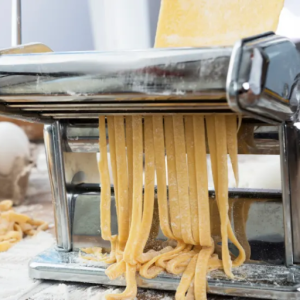
Key Features to Look for in a Pasta Maker
For a perfect pasta maker, the following are key features to consider that will help you choose a model that is suitable for your cooking needs:
- Material and Durability: Make sure that the pasta maker’s material is of high quality, like stainless steel, which ensures its durability and long life.
- Ease of Use: An easy assembly and comfortable crank handle will make working with the pasta machine enjoyable. Seek models that are smooth when operational and have minimum resistance.
- Adjustable Thickness Settings: This element is essential as it helps regulate how thin or thick your pasta can be, thus offering variability for different types of pasta.
- Versatility with Attachments: Most of these machines have interchangeable rollers or cutters, with which one can create different styles and shapes of pasta, hence making them multipurpose.
- Stability and Support: These appliances should have stable base platforms and secure clamping mechanisms that allow them to remain in place while being used, thereby generating uniform outcomes.
- Ease of Cleaning: Washable parts allow one to maintain hygiene by getting rid of dirt without using much energy, guaranteeing a longer service duration.
- Customer Reviews and Brand Reputation: Read customer reviews and stick to established brands to determine whether the product is reliable, efficient, or satisfying to end users.
Concentrate on these essential attributes, and then you will not go wrong when selecting a pasta noodle manufacturer capable of turning homemade dishes into delicious ones.
Comparing Popular Models: Marcato Atlas 150 vs. Imperia Pasta Maker
Marcato Atlas 150
The Marcato Atlas 150 is honored for its superb craftsmanship and performance. It is strong, durable, and built from chrome-plated steel. An adjustable dial offers nine thickness settings, making it easy for users to create pasta with a 0.3mm thickness and 2.5mm thick one. Also featured in the Atlas 150 are several attachments for creating other types of pasta like spaghetti, fettuccine, and lasagna, among others. The handle turns efficiently, reducing your effort while using it because the machine’s design has been made to be ergonomic. This means that taking them apart to clean them should not cause any problems, even if you have never done so before, since they are pretty simple in design and functionality. Further, Marcato is a trusted label with cheerful customer reviews about reliability and usability.
Imperia Pasta Maker
This is another Imperia Pasta Maker that has gained fame due to its robustness and versatility. Made from high-quality stainless steel, it can endure frequent use over time without breaking down or weakening. For home cooking, this machine comes with a 6-position thickness adjustment knob that provides sufficient flexibility when kneading dough together at home too quickly at all times! Additional ones sold separately consist of dual cutter attachments for producing either fettuccine or spaghetti strands/threads, with attachments available individually purchased by customers included as well. This model has an old-fashioned wooden grip handle compared to the other two machines above, making it more comfortable to hold while rolling out your dough or processing some kind of. Imperia, like the Marcato, can be cleaned efficiently, thus ensuring its long-standing brand reputation because these things disassemble into individual parts, which you may think look complicated but are not. After a few attempts, it will show this fact fine since Marcatos is supposed to be user-friendly. The company has developed its brand over the years. Most of its customers have always provided positive reviews about their products due to their durability and consistent performance.
Conclusion
One should consider many things before buying either Marcato Atlas 150 or Imperia Pasta Maker, each with its standout characteristics and advantages. Therefore, if you are after numerous options regarding thickness settings and attachment variety, go for the former. Still, someone who likes old-school design and a bit less complex setup may prefer the latter. You must weigh your personal taste in cooking to make a better choice between these two models.
Why Stainless Steel is the Best Material?
Stainless steel, due to its resilience, resistance to rusting, and ability to be easily cleaned, is considered the best material for kitchen utensils and appliances. It outlasts other materials because it does not perish or rust easily. Its non-porous surface also makes it hygienic since it does not bear microorganisms or smell. Moreover, stainless steel can endure high temperatures, so it is suitable for cooking and baking. Besides appearance, this type of metal is smooth and modern, making your kitchen design look more elegant. That’s why both home chefs and professional cooks like it.
What are the Best Manual Pasta Makers of 2024?
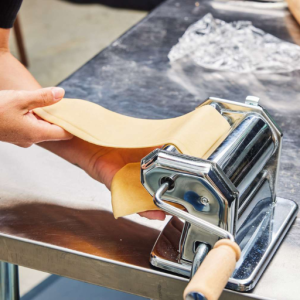
Different models of manual pasta makers have been exceptional when speaking about their performance, durability, and user-friendly designs in 2024. Here are some of them:
- Marcato Atlas 150: This pasta maker has a wide range of thickness settings and different attachments, so you can select according to the type of pasta you want.
- Imperia Pasta Maker: The Imperia’s traditional solid construction allows for easy usage with consistent results being produced at all times. Whether you are an experienced pasta maker or a beginner who wants simplicity, this device will still give you value.
- OxGord Pasta Maker Machine: With adjustable thickness settings and solid stainless steel construction that can last through daily usage, this model boasts excellent performance at an affordable price.
- CucinaPro Pasta Maker Deluxe Set: This deluxe set, among other things, has several different attachments to allow for all types of pasta shapes. Its chrome-coated body is made from superior-quality steel, which only means one thing—versatility and durability.
-
KitchenAid KSMPSA Pasta Roller Attachment: Though technically not a standalone unit but an attachment, the Kitchen Aid KSMPSA is compatible with Kitchen Aid mixers and has high-speed rolling capability, which is why customers most often prefer this option.
Top Choice: Marcato Atlas 150 Pasta Machine
These findings justify the top 2024 pick, unlike other pasta makers. According to those in the know, its durable structure, precision construction, and user-friendliness have distinguished it from others used for making pasta. A unique feature of this machine is a dial with adjustable thickness settings that allow people to customize their pasta as per their taste buds. This unit goes beyond being just an ordinary noodle maker; it can prepare different types of Italian pasta, such as ravioli. Users have said that it makes perfect restaurant-quality noodles every time, thus making them preferred by many cooks, from novices to professionals alike. Also, its extraordinary look and smooth surface give it a contemporary appearance that will improve performance and match any modern kitchen.
Budget-Friendly Option: Imperia Pasta Maker
Imperia Pasta Maker is widely known as the best option for those seeking homemade spaghetti on a budget. This machine has proven effective at reasonable prices due to its rugged build and ease of use. Furthermore, two cutting tools are included, enabling shoppers to choose between fettuccine and spaghetti according to their taste preferences when cooking this food item at home. The handle turns quickly and provides uniform dough rolling without mishaps or obstacles. On the other hand, Imperia Pasta Maker does not compromise with a low price tag because it is built firmly enough while still providing efficient homemade pasta that can compete favorably with their factory-made counterparts in terms of taste and texture. People who want to try making fresh noodles at home without spending too much should go for it.
Premium Selection: Atlas 150 Roller and Cutter Set
This pasta roller and cutter set is known as the Atlas 150 Roller and Cutter Set, which has been referred to by various top sources as the ultimate pasta maker with excellent performance. This product is known for its practicality and long-lasting quality, boasting a chrome-plated steel body and anodized aluminum rollers to ensure durability and hygiene over an extended period. The package comprises a fettuccine cutter, a tagliolini cutter, and a pasta roller, but one can purchase additional attachments to complement the standard set. Some people have likened it to being comparable to restaurant standards, producing thin pieces that are uniform in texture, making them ideal for garnishing or seasoning, among other meals. It is straightforward to handle since its turning mechanism feels smooth while attaching to surfaces tightly around; there is no need for any assistance. It is also designed to add elegance to our kitchen; hence, it is not only considered an appliance alone but also forms part of the culinary space fashion statement.
How to Make Fresh Pasta with a Manual Pasta Machine?
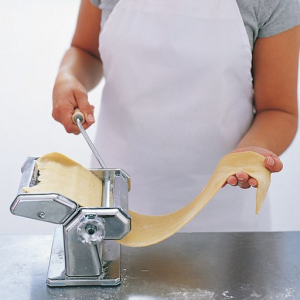
For fresh pasta, which is made with a manual pasta machine, please follow these simple steps:
- Prepare the Dough: Combine flour and eggs until you have formed a smooth and elastic dough. Let it rest for at least 30 minutes.
- Roll the Dough: Divide the dough into smaller portions. Flatten one portion and feed through the pasta machine rollers on their widest setting. Gradually bear down on the thickness control and keep rolling until you achieve your desired thickness.
- Cut the Dough: Connect your desired pasta cutter to the machine. Feed the rolled-out dough through this to make fettuccine, tagliolini, or any other shape that pleases your heart.
- Cook the Pasta: Boil a pot of salted water and cook for 2-3 minutes until al dente when using freshly prepared pasta. Drain them and add any sauce that goes well with them while they are still hot.
With these procedures, easy homemade pasta is simply possible.
Essential Ingredients for Homemade Pasta
You only need a few good-quality ingredients to make excellent homemade pasta. These are the crucial items required:
- Flour: The integral component of any paste that gives it texture and taste differences depending on its source. To make traditional Italian Pasta, the most recommended type of flour is “00” because it has been finely ground, leaving only high gluten, making it smooth and elastic when kneaded. One can also use flour from all-purpose or semolina mixed with “00.”
- Egg: Large, fresh eggs are necessary as they give color and richness to the paste. As a rule, take about one egg per hundred grams (approximately 3.5 ounces) of flour.
- Salt: A little pinch improves the flavor in the paste’s dough
- Olive Oil (Optional): A tablespoon or two may added to some doughs to introduce mild flavors while giving improvements in textures
By utilizing these essential elements and with necessary guidelines in making, cutting, and rolling dough, one can savor authentic homemade pasta with its genuine taste and consistency.
Step-by-Step Guide to Using a Pasta Roller
- Prepare Your Workspace: Ensure you have a clean, pristine surface. This will prevent the dough from sticking and enhance handling.
- Divide the Dough: Split your prepared pasta dough into smaller pieces. Such will make it easier to roll and control.
- Flatten the Dough: Flatten one portion of the dough with either hands or a rolling pin into an oval shape. The dough should be thin enough to pass through a roller.
- Set the Roller: Start on the widest roller setting. Introduce dough into the rollers while the handle is being turned. Catch it with your hand as it comes out and lies flat.
- Fold and Repeat: In particular, folding in thirds, like folding a letter, has been preferred. In this step, structuring gluten correctly is essential for better end texture. At this point, run it through again on its widest setting, just described above. Do this about three to five times over.
- Thin the Dough: Gradually change the pasta roller to narrower settings and allow the piece of dough to pass through so that you can do it again. On each pass, decrease the setting width until you attain the desired thickness. This action should be done progressively, one step at a time.
- Cut the Pasta: Once you attain the right thickness, transfer the dough onto the attachment of the pasta cutter. Feed the flattened dough through the cutter, making shapes such as spaghetti or fettuccine.
- Dry the Pasta: Spread the cut pasta over a clean, floured surface or hang it on a drying rack to avoid sticking before cooking.
Following these steps, you can efficiently use a pasta roller to create perfect, uniform pasta at home.
Tips for Perfect Pasta Dough Every Time
- Quality Ingredients: Use high-quality flour such as ’00’ or semolina and fresh eggs. The quality of the ingredients will significantly affect the final texture and taste.
- Correct Proportions of Ingredients: Strike a balance between eggs and flour. A standard ratio is one large egg for every 100 grams of flour, ensuring the dough isn’t too sticky or dry.
- Thorough Kneading: Properly knead the dough by hand for about 10 minutes until it’s smooth and elastic. Adequate kneading enables gluten formation, hence better pasta texture.
- Dough Rest Time: Wrap the dough in plastic wrap and let it rest for at least thirty minutes. This reduces its elasticity and thus enhances its rolling-out ability.
- Uniform Rolling: Gradually roll out your dough, steadily reducing the thickness with each roller pass to ensure it’s uniform without breaking.
- Cover Your Dough: To prevent the dough from drying out, cover it in plastic or under a wet cloth when not in use.
- Ingredients at Room Temperature: Make use of room temperature ingredients. Using cold eggs or flour can hinder the mixing process for consistency in your dough.
By following these suggestions, you’ll always be able to make perfect pasta every time.
Can You Use a Pasta Maker Attachment with a KitchenAid?
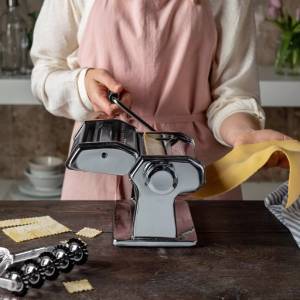
Yes, the KitchenAid mixer fits on all kitchenAid attachments. The KitchenAid pasta maker attachments easily snap onto any KitchenAid stand mixer’s hub. These include machines that flatten pasta uniformly before cutting it into spaghetti, fettucini, and lasagna. A Kitchen Aid Pasta Maker attachment like this can help you streamline production while ensuring consistent results every time—saving you time compared to making pasta by hand.
Types of Pasta Maker Attachments Available
KitchenAid mixers pasta maker attachments have various types suitable for different pasta-making needs. Here are some of the most popular ones:
- Roller and Cutter Attachments: These sets usually consist of a roller for dough flattening and cutters for different pasta shapes. One example is the KitchenAid 3-Piece Pasta Roller and Cutter Set, which has high ratings and can be used to make spaghetti, fettuccine, and lasagna.
- Pasta Extruder Attachment: This attachment helps you prepare pasta in various forms by pressing dough through various disc plates. With the KitchenAid Gourmet Pasta Press, you get discs for making bucatini, rigatoni, fusilli, and more.
- Ravioli Maker Attachment: This specialty device assists in producing filled pasta like ravioli. It involves rolling out the dough and adding your choice of filling, ensuring that the resulting ravioli looks professional.
KitchenAid stand mixer attachments are built with compatibility in mind; thus, they can easily integrate into your kitchen appliances, making it easy and convenient to cook homemade pasta using this method.
How to Install and Use the KitchenAid Pasta Roller Attachment
Installing the Pasta Roller Attachment:
- Make Ready the Stand Mixer: Switch it off and unplug before attaching the roller to your KitchenAid stand mixer.
- Attach the Roller: Unscrew the thumb screw to remove the attachment hub cover. As you insert the Pasta Roller into the attachment hub, ensure the power shaft fits into the square hub socket. Rotate back and forth if necessary to align correctly. Tighten the thumb screw to secure the roller.
Using the Pasta Roller Attachment:
- Using Pasta Roller Attachment Preparation of Dough: Flatten dough to take a rectangular shape. At this point, begin with an adjustment knob for the roller at its widest setting, usually “1”.
- Feeding Dough: Turn on a stand mixer speed settings 2 or 4. Feed dough through rollers. Fold in half and re-feed, going through twice; repeat this process until the dough is smooth and has an elastic texture.
- Thickness Adjustment: After getting a smooth dough, change the roller to a thinner setting, then pass the dough through again. Gradually reduce the thickness settings until you reach the desired thickness.
- Cutting Pasta: Attach the preferred cutter (spaghetti or fettuccine) to the mixer. Feed rolled out dough through cutter as pasta drops out from opposite side. Put cut pasta on a floured surface so as not to stick.
- Cooking Pasta: Fresh pasta cooks quickly, usually within 2-4 minutes in boiling water. Serve immediately with your favorite sauce.
By following these steps, you can make more varieties of pasta using a Kitchen Aid Pasta Roller Attachment, which results in a genuine homemade pasta experience.
Best Noodle Maker Attachments for Different Pasta Shapes
- Attachment for Spaghetti Cutter: This is the best tool for making classic, long spaghetti strands. It is appropriate for preparing Italian dishes such as carbonara and bolognese. Its smooth, round shape helps the pasta absorb the sauce, making it suitable for many dishes.
- Fettuccine Cutter Attachment: This attachment allows you to produce broader noodles suitable for heavy sauces. Among the best combinations you can have with fettuccine are Alfredo sauce, which is usually creamy, and ragù, which normally has meat in it. Much more space on these noodles makes them hold thick sauces better, thus improving your overall eating-out experience.
- Ravioli Maker Attachment: If you enjoy stuffed pasta, you must get yourself a ravioli maker attachment. It permits you to fill and seal pasta sheets with the stuffings you love most, like ricotta cheese and spinach or mixtures of ground meat. This accessory guarantees uniformly shaped and uniformly sealed ravioli; therefore, even less experienced cooks can create first-class restaurant food at home.
These attachments exponentially increase the options for your homemade pasta dish by enabling you to easily create various kinds of pasta shapes, leading to different textures and accompaniments for distinctive sauces.
Frequently Asked Questions (FAQs)
Q: What makes a manual pasta maker better than an electric machine for homemade pasta?
A: A manual pasta maker gives you more control over the pasta-making process, allowing you to fine-tune the thickness setting and hand crank at your own pace. They are also generally more affordable and durable compared to electric machines.
Q: How do I choose the best pasta maker for home use?
A: To find the best pasta maker, consider factors like ease of use, durability, available thickness settings, and additional attachments like a pasta cutter or a pasta press. Reading reviews and comparing features can also help you find the best option.
Q: Can I use a manual pasta maker with a KitchenAid stand mixer?
A: There are attachments for pasta makers designed explicitly for KitchenAid stand mixers. These attachments allow you to use your mixer to roll out sheets of pasta and cut noodles, combining the convenience of an electric machine with the control of a manual model.
Q: What types of pasta can I make with a manual pasta maker?
A: With a manual pasta maker, you can make various types of pasta, including sheets of pasta for lasagna, fettuccine, spaghetti, and even filled pasta like ravioli. Some models come with different cutter attachments to create different noodle shapes.
Q: Is a stainless steel manual pasta maker better than other materials?
A: A stainless steel manual pasta maker is often preferred because it is durable, easy to clean, and resistant to rust. This ensures the machine’s longer lifespan and better hygiene while making pasta.
Q: What additional equipment do I need to make pasta at home?
A: In addition to a pasta maker, you may need a pasta drying rack to dry your noodles, a good dough recipe, and a cutter attachment if your machine doesn’t come with one. A rolling pin can also be handy for rolling out dough sheets evenly.
Q: How do I maintain and clean my manual pasta maker?
A: To maintain your manual pasta maker, dismantle the removable parts after use and clean them with a dry cloth or brush to remove any dough residue. Avoid using water unless the manufacturer states it is safe, as water can cause rust, especially in non-stainless steel models.
Q: What are the advantages of using a gourmet pasta press attachment?
A: A gourmet pasta press attachment allows you to create high-quality shapes and textures. These attachments usually offer more sophisticated pasta and noodle maker options, making them ideal for those who want to explore diverse recipes and impress guests with gourmet pasta.
Q: Are there any specific pasta makers recommended in 2024?
A: The best pasta makers of 2024 include several top-rated manual machines. These models are highly regarded for their performance, ease of use, and durability. Checking updated review lists will help you find the best pasta makers to suit your needs.
Q: How can I ensure my home pasta is as good as gourmet pasta?
A: To make gourmet pasta at home, use high-quality ingredients, follow a reliable recipe, and utilize your pasta maker’s full range of features, such as different thickness settings and cutter attachments. Properly drying your pasta using a rack can enhance the texture and taste.












